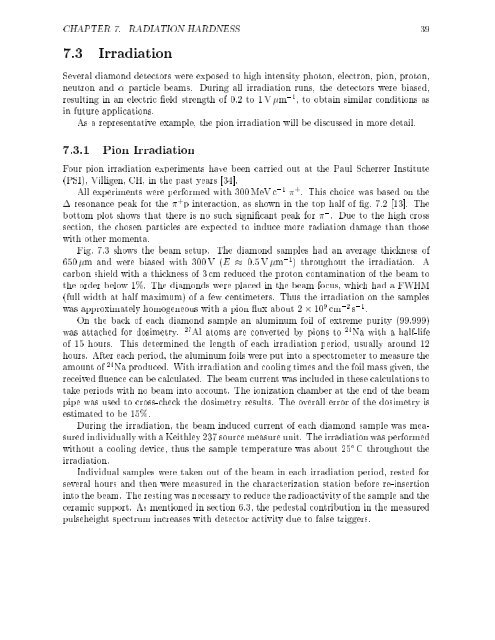Diamond Detectors for Ionizing Radiation - HEPHY
Diamond Detectors for Ionizing Radiation - HEPHY
Diamond Detectors for Ionizing Radiation - HEPHY
Create successful ePaper yourself
Turn your PDF publications into a flip-book with our unique Google optimized e-Paper software.
CHAPTER 7. RADIATION HARDNESS 39<br />
7.3 Irradiation<br />
Several diamond detectors were exposed to high intensity photon, electron, pion, proton,<br />
neutron and particle beams. During all irradiation runs, the detectors were biased,<br />
resulting in an electric eld strength of 0:2 to 1Vm ,1 , to obtain similar conditions as<br />
in future applications.<br />
As a representative example, the pion irradiation will be discussed in more detail.<br />
7.3.1 Pion Irradiation<br />
Four pion irradiation experiments have been carried out at the Paul Scherrer Institute<br />
(PSI), Villigen, CH, in the past years [34].<br />
All experiments were per<strong>for</strong>med with 300 MeV c ,1 + . This choice was based on the<br />
resonance peak <strong>for</strong> the + p interaction, as shown in the top half of g. 7.2 [13]. The<br />
bottom plot shows that there is no such signicant peak <strong>for</strong> , . Due to the high cross<br />
section, the chosen particles are expected to induce more radiation damage than those<br />
with other momenta.<br />
Fig. 7.3 shows the beam setup. The diamond samples had an average thickness of<br />
650 m and were biased with 300 V (E 0:5Vm ,1 ) throughout the irradiation. A<br />
carbon shield with a thickness of 3 cm reduced the proton contamination of the beam to<br />
the order below 1%. The diamonds were placed in the beam focus, which had a FWHM<br />
(full width at half maximum) of a few centimeters. Thus the irradiation on the samples<br />
was approximately homogeneous with a pion ux about 2 10 9 cm ,2 s ,1 .<br />
On the back of each diamond sample an aluminum foil of extreme purity (99.999)<br />
was attached <strong>for</strong> dosimetry. 27 Al atoms are converted by pions to 24 Na with a half-life<br />
of 15 hours. This determined the length of each irradiation period, usually around 12<br />
hours. After each period, the aluminum foils were put into a spectrometer to measure the<br />
amount of 24 Na produced. With irradiation and cooling times and the foil mass given, the<br />
received uence can be calculated. The beam current was included in these calculations to<br />
take periods with no beam into account. The ionization chamber at the end of the beam<br />
pipe was used to cross-check the dosimetry results. The overall error of the dosimetry is<br />
estimated to be 15%.<br />
During the irradiation, the beam induced current of each diamond sample was measured<br />
individually with a Keithley 237 source measure unit. The irradiation was per<strong>for</strong>med<br />
without a cooling device, thus the sample temperature was about 25 C throughout the<br />
irradiation.<br />
Individual samples were taken out of the beam in each irradiation period, rested <strong>for</strong><br />
several hours and then were measured in the characterization station be<strong>for</strong>e re-insertion<br />
into the beam. The resting was necessary to reduce the radioactivity of the sample and the<br />
ceramic support. As mentioned in section 6.3, the pedestal contribution in the measured<br />
pulseheight spectrum increases with detector activity due to false triggers.












